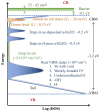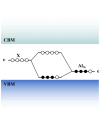A Review of Wide Bandgap Semiconductors: Insights into SiC, IGZO, and Their Defect Characteristics
- PMID: 39453015
- PMCID: PMC11510050
- DOI: 10.3390/nano14201679
A Review of Wide Bandgap Semiconductors: Insights into SiC, IGZO, and Their Defect Characteristics
Abstract
Although the irreplaceable position of silicon (Si) semiconductor materials in the field of information has become a consensus, new materials continue to be sought to expand the application range of semiconductor devices. Among them, research on wide bandgap semiconductors has already achieved preliminary success, and the relevant achievements have been applied in the fields of energy conversion, display, and storage. However, similar to the history of Si, the immature material grown and device manufacturing processes at the current stage seriously hinder the popularization of wide bandgap semiconductor-based applications, and one of the crucial issues behind this is the defect problem. Here, we take amorphous indium gallium zinc oxide (a-IGZO) and 4H silicon carbide (4H-SiC) as two representatives to discuss physical/mechanical properties, electrical performance, and stability from the perspective of defects. Relevant experimental and theoretical works on defect formation, evolution, and annihilation are summarized, and the impacts on carrier transport behaviors are highlighted. State-of-the-art applications using the two materials are also briefly reviewed. This review aims to assist researchers in elucidating the complex impacts of defects on electrical behaviors of wide bandgap semiconductors, enabling them to make judgments on potential defect issues that may arise in their own processes. It aims to contribute to the effort of using various post-treatment methods to control defect behaviors and achieve the desired material and device performance.
Keywords: 4H-SiC; a-IGZO; charge transition levels; defects; formation energy; post-process; stability.
Conflict of interest statement
The authors declare no conflicts of interest.
Figures

















Similar articles
-
Power Electronics Revolutionized: A Comprehensive Analysis of Emerging Wide and Ultrawide Bandgap Devices.Micromachines (Basel). 2023 Oct 31;14(11):2045. doi: 10.3390/mi14112045. Micromachines (Basel). 2023. PMID: 38004900 Free PMC article. Review.
-
Superinjection of Holes in Homojunction Diodes Based on Wide-Bandgap Semiconductors.Materials (Basel). 2019 Jun 19;12(12):1972. doi: 10.3390/ma12121972. Materials (Basel). 2019. PMID: 31248087 Free PMC article.
-
Status and Prospects of Cubic Silicon Carbide Power Electronics Device Technology.Materials (Basel). 2021 Oct 5;14(19):5831. doi: 10.3390/ma14195831. Materials (Basel). 2021. PMID: 34640228 Free PMC article. Review.
-
Nanoscale Infrared Spectroscopic Characterization of Extended Defects in 4H-Silicon Carbide.Nano Lett. 2024 Jan 10;24(1):114-121. doi: 10.1021/acs.nanolett.3c03369. Epub 2024 Jan 2. Nano Lett. 2024. PMID: 38164942
-
Power Electronic Semiconductor Materials for Automotive and Energy Saving Applications - SiC, GaN, Ga2O3, and Diamond.Z Anorg Allg Chem. 2017 Nov 17;643(21):1312-1322. doi: 10.1002/zaac.201700270. Epub 2017 Oct 20. Z Anorg Allg Chem. 2017. PMID: 29200530 Free PMC article. Review.
References
-
- Hosono H., Yasukawa M., Kawazoe H. Novel oxide amorphous semiconductors: Transparent conducting amorphous oxides. J. Non-Cryst. Solids. 1996;203:334–344. doi: 10.1016/0022-3093(96)00367-5. - DOI
-
- Hosono H., Kikuchi N., Ueda N., Kawazoe H. Working hypothesis to explore novel wide band gap electrically conducting amorphous oxides and examples. J. Non-Cryst. Solids. 1996;198–200:165–169. doi: 10.1016/0022-3093(96)80019-6. - DOI
Publication types
Grants and funding
LinkOut - more resources
Full Text Sources

